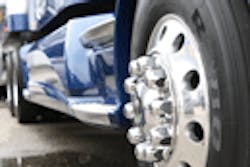Study: “Aluminum intensive” trucks deliver significant savings
A recent study conducted by research firm Ricardo Inc. has found that wider use of aluminum components on Class 8 tractors and trailers could remove some 3,300 lbs of total vehicle weight. That would give freight haulers an extra 6.5% of payload capacity or boost their fuel efficiency by 6.5% – saving anywhere from 777 to 1,612 gallons of diesel per year, when assuming 100,000 miles traveled. And it would cut carbon dioxide (CO2) emissions between 8.6 tons and 17.9 tons annually.
The study – funded by the Aluminum Association – focused on three simulated configurations of vehicles and three payload conditions: unloaded, full gross vehicle weight [GVW] and half-GVW loads. The three vehicle configurations studied included: a conventional Class 8 tractor-trailer as the baseline; a conventional big rig incorporating typical lightweight options; and an “aluminum-intensive vehicle” that reduces the conventional tractor-trailer model by 3,300 lbs.
Ricardo noted that the report, titled “Fuel Efficiency Impact of Vehicle Weight Reduction in Class 8 Trucks,” covered the major duty cycles within U.S. commercial transportation using a physics-based model developed for a 2010-emission compliant Class 8 truck equipped with selective catalytic reduction (SCR) technology.
“This is an important area, looking at how weight reductions affect fuel efficiency and payload,” Randall Scheps, chairman of the Aluminum Association’s Aluminum Transportation Group and director of ground transportation for Alcoa, told FleetOwner.
“We brought in a third-party research firm to perform rigorous analysis on this question so we could put a stake in the ground regarding potential fuel savings and freight efficiency gains from more aluminum-intensive truck designs,” he explained.
Truck frame rails, wheels and cabs represented the biggest areas where aluminum use could generate big weight savings – 440, 350, and 330 lbs, respectively – with miscellaneous suspension components garnering another 145 lbs in savings. For trailers, the largest slimming effects would be felt in sidewalls (985 lbs), wheels (285 lbs, in a dual configuration), and doors (185 lbs).
“Our point is that the best way to deliver improved fuel economy – something demanded by efforts to control greenhouse gas (GHG) emissions – without sacrificing performance is to reduce total vehicle weight,” Scheps said.
Even with the higher initial cost of aluminum components factored in and diesel fuel pricing staying around $3 per gallon, most fleets would see a payback from such an initial investment in aluminum components in less than three years, he noted. “Of course, if diesel fuel prices increase – which we hope they won’t do – that payback period shortens even more,” Scheps pointed out.
The overall conclusion of the study is that significant freight efficiency, fuel economy, and emission reduction gains are available via wider use of aluminum components. And these gains can bolster other improvements in aerodynamics, engine optimization, spec’ing low rolling resistance tires, etc.
Considering these results for the total U.S. fleet of approximately two million Class 8 vehicles, Ricardo said the overall impact of weight savings may be on the order of one billion gallons of diesel and 10 million tons of CO2 per year.
“We’re finding that after the fuel price hikes the trucking industry experienced back in 2008, combined with the impact of current and future emission regulations, fleets are now far more willing to explore using more lightweight materials in their vehicles,” Scheps said.
About the Author
Sean Kilcarr
Editor in Chief
Sean Kilcarr is a former longtime FleetOwner senior editor who wrote for the publication from 2000 to 2018. He served as editor-in-chief from 2017 to 2018.
